Attending the ceremony were Mr. Nguyen Trong Nghia - Politburo member, Secretary of the Party Central Committee, Head of the Central Propaganda Department; Mr. Nguyen Hoa Binh - Politburo member, Permanent Deputy Prime Minister of the Government...

At the ceremony, Mr. Mai Liem Truc - former Permanent Deputy Minister of the Ministry of Posts and Telecommunications, on behalf of the Central Southern Student Liaison Committee, said that after the Geneva Agreement on July 21, 1954, with a far-sighted vision, President Ho Chi Minh and the Party Central Committee had a premonition that the struggle for independence and national reunification might be long and arduous.
Therefore, along with the transfer of troops and resistance cadres to the North, it was necessary to send a large number of children and students who were the children of cadres and soldiers to the North for care and training, so that they would later become the core force to rebuild the South and rebuild the country.
On the other hand, the revolutionary cadres and soldiers remaining in the South will also fight with peace of mind knowing that their children are in the "arms" of Uncle Ho and the people of the North, being well cared for and receiving a proper education.

From late 1954 to early 1955, tens of thousands of children and students from Quang Tri came to Ca Mau and the Central Highlands by many different routes, including more than 20,000 people going by sea... to the North.
In the early days, students from the South were assigned to stay with families in Nghe An, Thanh Hoa, Thai Binh...
"Our generation of students from the South will never forget the cold winter days when people burned firewood to keep us warm; at night people brought straw to cover our beds; in the morning we got to eat hot pots of sweet potatoes and cassava, even though at that time our people were still poor, lacking food and clothing," Mr. Truc was moved.
At that time, excellent teachers were selected along with loving nurses, nannies, and caregivers, who accepted to leave their families to live and work in boarding schools, taking the place of their parents to raise their children. The teachers provided comprehensive training for Southern students, first of all, in learning how to be human, cultivating character, especially honesty, gratitude, collective consciousness, and dedication to the common work.
Since 1964, when the US sent troops to the South and expanded the war of destruction to the North, hundreds of Southern high school graduates went to the South to fight.
"Many comrades heroically sacrificed their lives at a very young age. They will forever be role models for the young generation of the whole country, especially for students in the South to follow," said Mr. Mai Liem Truc.

Southern students who stayed in the North or graduated from universities abroad continued to join the army, police and other essential sectors, participating in the fight against the war of destruction in the North and building a strong Northern rear to support the South.
When the country entered the renovation period from 1986, generations of Southern students continued to strive, be dedicated and creative in their duties, actively contributing to the country's renovation.
Sending more than 30,000 children and students from the South to the North and establishing a system of schools for Southern students in the North from 1954 to 1975 was a major policy of extremely important significance, not only demonstrating a clear vision but also expressing the noble sentiments of Uncle Ho, the Party, the State and the people of the North towards the children of our compatriots, cadres and soldiers from the beloved South.
Late Prime Minister Pham Van Dong once commented, "This is a special nursery, nurturing the most precious seeds that Uncle Ho, the Party, the State and the people of the North gave to the South during difficult days."
At the same time, it can be affirmed that the largest-scale movement of children and students in history is considered successful in all three aspects: human training, educational model and long-term training strategy.
"Southern students have had very special feelings for Uncle Ho throughout their lives. Uncle Ho's teachings along with infinite gratitude are valuable assets for each Southern student to make every effort to serve the country and the people," according to Dr. Mai Liem Truc.









